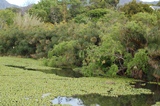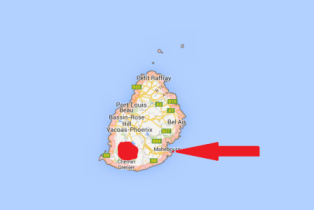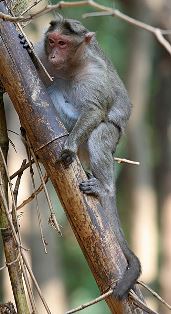Weaver species
Choose different species from drop-down list and press 'Go' button. See Full species list.Mauritius Fody Foudia rubra
IUCN: Endangered Discovery: 019Categories: island, Foudia, fruit, gum, IUCN, nectar, blue eggs,
News items about species
Discovery
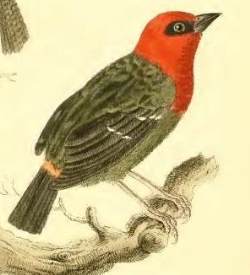
figure from Brown 1776 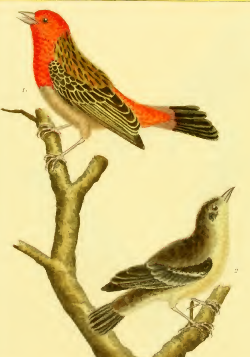
figure from Daubenton 1783 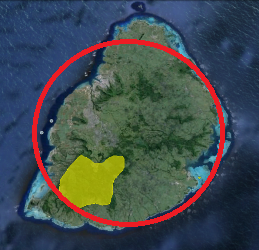
distribution, type locality circled IntroductionThe Mauritius Fody was formally named by Johann Friedrich Gmelin, a German naturalist. Gmelin described many new bird species in a book in 1789 in the style of Linnaeus' publications, giving a brief description in Latin and a synonomy, including a reference to the coloured engraving by Francois-Nicolas Martinet in the book edited by Edme-Louis Daubenton. The illustration in Daubenton 1783 is of a male, and the first female to be painted, but Buffon does not appear to have written about it. Gmelin noted the locality for the Mauritius Fody as "insula Franciae".Gmelin 1789 (p903) also described Fringilla erythrocephala, based on the first illustration of the Mauritius Fody, ie. by Peter Brown, an English naturalist and illustrator. Gmelin did not realise that the same species was involved, due to the slight differences in the artwork. The Latin name he provided here was invalid. Gmelin noted the locality for this Mauritius Fody specimen as "insula Mauritii". Peter Brown was the first to illustrate, the Mauritius Fody. He called it the Red-headed Finch and gave a description of the bird. Brown notes that the bird was in the collection of Marmaduke Tunstall, an English ornithologist and collector. The fody would have been brought by ship from Mauritius to England, where it would have been purchased by Tunstall. Tunstall kept it in captivity for several years (Fox 1827). Brown's painting appeared before that of Daubenton, but these paintings were probably based on different specimens, so all that can be said about the collection details is that the type specimen was taken before 1783 by an unknown collector. This is the last weaver described by Gmelin. Scientific citationEmberiza rubra Gmelin 1789 Syst. Nat., 1(2), p.877 Isle de France [=Mauritius].Meaning of namesruber (Latin): red, ruddy.First English nameThe Red headed Finch (Brown 1776).Alternate namesNone (historic: Red-headed Finch, Crimson Bunting)CollectorUnknown.Date collectedBefore 1783.Locality collectedinsula Franciae= Mauritius. The historic distribution of the Mauritius Fody ranged over much of Mauritius, so the type could have been collected anywhere on the island.Type specimensType specimen no longer exists; the illustration of Daubenton 1783 serves as a type. |
The above is based on Weaver Wednesday 2, a weekly series about the discovery of each weaver species.
This species text first appeared as
Weaver Wednesday [136] - Discovery [19]: Mauritius Fody on 2015-01-21
1. Basic biology
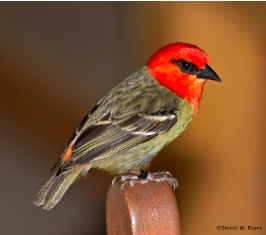
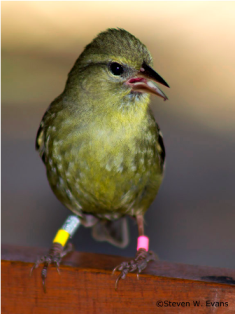
Identification. The Mauritius Fody Foudia rubra is found only on Mauritius Island and is listed as Endangered since it has an extremely small population. The male in breeding plumage has the head red or orange-red, with a black mask through the eye; the lower rump and uppertail-coverts are orange-red, and the rest of the body is olive-grey. The female and non-breeding male are dull olive-green, with a yellowish wash below. The juvenile resembles the female, except for a paler brown bill, which may be retained for its first year. The non-breeding male, female and juvenile may be separated from the Madagascar Fody by their darker, less streaked plumage, plumper body, relatively shorter tail, and different calls.
Distribution. The Mauritius Fody is restricted to south-west Mauritius (see red polygon on map) where there are 3 small sub-populations. In 2005, hand reared chicks were released onto the offshore islet Ile aux Aigrettes where the species apparently occurred historically (red arrow on map, see also news). The population on Ile aux Aigrettes increased to 217 in September 2011, but declined to 165-170 birds in early 2012 (IUCN). Translocations to Round Island in 2010 and 2011 were unsuccessful, largely due to predation by Round Island boas Casarea dussumieri. The main threats to the Mauritius Fody has been habitat destruction and the introduction of predators, such as black rats Rattus rattus and Crab-eating Macaques Macaca fascicularis. However, since 1993, the population has been stable due to conservation action, the population being about 140-170 adults and an estimated 108 pairs in 2012. It can co-exist with the introduced Madagascar Red Fody.
Habitat. The Mauritius Fody inhabits remaining native forest but also survives in degraded forest that has been invaded by exotics, as well as forests of exotics such as pines. Food.
The Mauritius Fody is mainly insectivorous, and feeds on grasshoppers, beetle larvae, caterpillars, and also spiders. Berries are eaten regularly by some individuals. It feeds on nectar regularly, using its specialised brush-tipped tongue. It forages in dead leaves, and probes bark and epiphytes, and gleans from leaves, for invertebrates. It is usually found singly, in pairs or in family groups.
Breeding. The Mauritius Fody is monogamous and territorial. Birds may have long-term pair bonds and remain on their territories year-round. The nest is domed, with a side entrance and often with a porch. Nests are built by both sexes using grass with moss, lichens or small twigs. Nest material is gathered within 100 m of the nest. The female adds lining, mainly feathers, before egg-laying and up to 8 days into incubation. Nests may be strong, able to withstand gale force winds, but others have less secure attachments leading to active nests falling to the ground. Nests are built in trees, usually hidden in foliage. Many tree species have been recorded as nest sites, but with exotics being used increasingly since the 1970s. Some pairs habitually desert their nests, while others rarely do so. The clutch is 2-3 pale blue eggs. Incubation is by the female. Initially the female feeds the young, and later chicks are fed by both sexes. Breeding success is low, with predation being the major cause of nest loss. |
The above is based on Weaver Wednesday, a weekly series about weaver species.
This species text first appeared as
Weaver Wednesday [64]: Mauritius Fody on 2013-09-04
2. Breeding facts
| Pair bond Monogamous Breeding season Oct-Feb Nest site placed 2-9 m above ground in tree Nest building division of work unclear, as both sexes seen to carry material, but in some cases female did most building Colony size No information Clutch size 2-3 eggs Egg colour pale blue Egg size average size of ten eggs 19.2 x 13.9 mm Incubation incubation apparently by female only, period reported as 14 days Chicks and nestling period chicks fed by both sexes, nestling period recorded as 18 days |
Breeding information based on Handbook of the Birds of the World, Vol. 15.
3. Photos of Weaver Nests
 Vm 9621 |  Vm 9620 |  Vm 9619 |  Vm 9522 |
Thumb-nails of most recent PHOWN records - click on one to see its full record
See all PHOWN records for this species here.
PHOWN (Photos of Weaver Nests) provides valuable info on breeding distribution and colony sizes of weavers.
You can contribute by registering and submitting photos at Virtual Museum webpage.
4. Breeding distribution
Google map showing distribution (For species with small ranges you need to zoom in at the correct area to see the range):
yellow blob - range of weaver species; read more about this here.
![]() - PHOWN records with photos
- PHOWN records with photos
![]() - PHOWN records with no photos (Nest Record Cards, other records)
- PHOWN records with no photos (Nest Record Cards, other records)
![]() - Birdpix records
- Birdpix records
![]() - comments on out of range records, or interesting records
- comments on out of range records, or interesting records
![]() - type locality
- type locality
CLICK on the marker on the map to see individual record details.
5. Range changes
Not South African speciesThe above is based on Weaver Wednesday 3, a weekly series about range changes in South African weaver species.
This species text first appeared as
n/a








